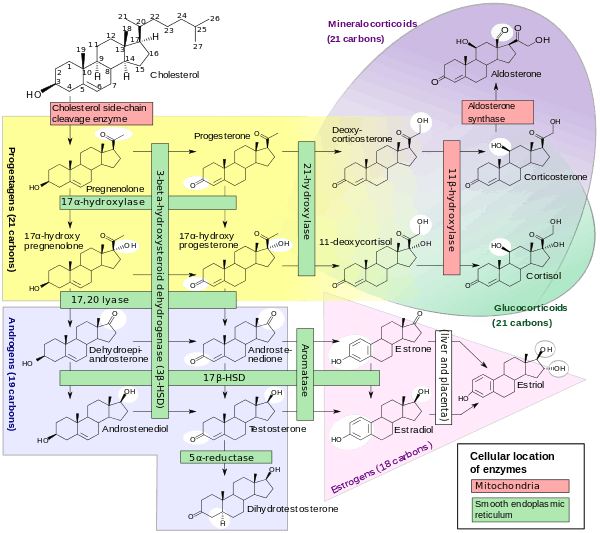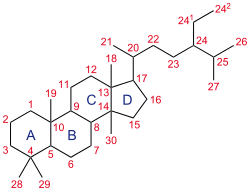21-Hydroxylase
| View/Edit Human | View/Edit Mouse |
Steroid 21-hydroxylase is a cytochrome P450 enzyme that is involved with the biosynthesis of the steroid hormones aldosterone and cortisol.[3]
In humans, 21-Hydroxylase is encoded by the gene CYP21A2.[4]
Function
This gene encodes a member of the cytochrome P450 superfamily of enzymes. The cytochrome P450 proteins are monooxygenases which catalyze many reactions involved in drug metabolism and synthesis of cholesterol, steroids and other lipids. This protein localizes to the endoplasmic reticulum and hydroxylates steroids at the 21 position. Its activity is required for the synthesis of steroid hormones including cortisol and aldosterone.[5]
Clinical significance
A defect within the CYP21A2 gene causes a disturbance of the development of the enzyme, which leads to congenital adrenal hyperplasia due to 21-hydroxylase deficiency. A related pseudogene is located near this gene; gene conversion events involving the functional gene and the pseudogene are thought to account for many cases of steroid 21-hydroxylase deficiency.[5]
Names and classification
| Steroid 21-monooxygenase | |||||||||
|---|---|---|---|---|---|---|---|---|---|
| Identifiers | |||||||||
| EC number | 1.14.99.10 | ||||||||
| CAS number | 9029-68-9 | ||||||||
| Databases | |||||||||
| IntEnz | IntEnz view | ||||||||
| BRENDA | BRENDA entry | ||||||||
| ExPASy | NiceZyme view | ||||||||
| KEGG | KEGG entry | ||||||||
| MetaCyc | metabolic pathway | ||||||||
| PRIAM | profile | ||||||||
| PDB structures | RCSB PDB PDBe PDBsum | ||||||||
| Gene Ontology | AmiGO / EGO | ||||||||
| |||||||||
21-Hydroxylase is also called steroid 21-monooxygenase, 21α-Hydroxylase, and, less commonly 21β-Hydroxylase.
Reaction
21-Hydroxylase catalyses the hydroxylation of the carbon atom 21 in steroids (adding an "–OH"), which is necessary with the formation of these hormones.
|
Pathway
 Human steroidogenesis, showing both reactions of 21-Hydroxylase at center top. |
 Corticosteroid biosynthetic pathway in the rat. |
References
- ↑ "Human PubMed Reference:".
- ↑ "Mouse PubMed Reference:".
- ↑ Ryan KJ, Engel LL (Mar 1957). "Hydroxylation of steroids at carbon 21" (PDF). The Journal of Biological Chemistry. 225 (1): 103–14. PMID 13416221.
- ↑ Higashi Y, Yoshioka H, Yamane M, Gotoh O, Fujii-Kuriyama Y (May 1986). "Complete nucleotide sequence of two steroid 21-hydroxylase genes tandemly arranged in human chromosome: a pseudogene and a genuine gene". Proceedings of the National Academy of Sciences of the United States of America. 83 (9): 2841–5. Bibcode:1986PNAS...83.2841H. doi:10.1073/pnas.83.9.2841. PMC 323402
 . PMID 3486422.
. PMID 3486422. - 1 2 "Entrez Gene: CYP21A2 cytochrome P450, family 21, subfamily A, polypeptide 2".
Further reading
- White PC, Tusie-Luna MT, New MI, Speiser PW (1994). "Mutations in steroid 21-hydroxylase (CYP21)". Human Mutation. 3 (4): 373–8. doi:10.1002/humu.1380030408. PMID 8081391.
- Helmberg A (Aug 1993). "Twin genes and endocrine disease: CYP21 and CYP11B genes". Acta Endocrinologica. 129 (2): 97–108. doi:10.1530/acta.0.1290097. PMID 8372604.
- de-Araujo M, et al. (Jan 1996). "Molecular analysis of CYP21 and C4 genes in Brazilian families with the classical form of steroid 21-hydroxylase deficiency". Brazilian Journal of Medical and Biological Research. 29 (1): 1–13. PMID 8731325.
- Yu CY (1999). "Molecular genetics of the human MHC complement gene cluster". Experimental and Clinical Immunogenetics. 15 (4): 213–30. doi:10.1159/000019075. PMID 10072631.
- Forest MG, et al. (Jun 2005). "21-Hydroxylase deficiency: an exemplary model of the contribution of molecular biology in the understanding and management of the disease". Annales d'endocrinologie. 66 (3): 225–32. doi:10.1016/s0003-4266(05)81754-8. PMID 15988383.
External links
- GeneReviews/NCBI/NIH/UW entry on 21-Hydroxylase-Deficient Congenital Adrenal Hyperplasia
- OMIM entry on 21-Hydroxylase-Deficient Congenital Adrenal Hyperplasia
- Synthesis of Desoxycorticosterone from Progesterone through 21-Hydroxylase (Image)
- Steroid 21-Hydroxylase at the US National Library of Medicine Medical Subject Headings (MeSH)
- Human CPS1 genome location and CPS1 gene details page in the UCSC Genome Browser.
- Human CYP21A2 genome location and CYP21A2 gene details page in the UCSC Genome Browser.
This article incorporates text from the United States National Library of Medicine, which is in the public domain.



